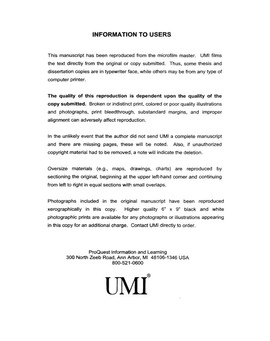| dc.contributor.advisor | O'Hair, H. Dan, | en_US |
| dc.contributor.author | Mazur, Michelle Ann. | en_US |
| dc.date.accessioned | 2013-08-16T12:18:15Z | |
| dc.date.available | 2013-08-16T12:18:15Z | |
| dc.date.issued | 2001 | en_US |
| dc.identifier.uri | https://hdl.handle.net/11244/313 | |
| dc.description.abstract | Overall, the results revealed that parents are generally knowledgeable about the types and quantity of media their adolescents' use. Furthermore, parents may try to employ parental mediation strategies, but may not be effective in their communication of these attempts or their adolescents are simply ignoring them. Finally, creating an environment of openness in the family may aid parents in utilizing parental mediation strategies. | en_US |
| dc.description.abstract | This dissertation investigated parental knowledge of adolescent media consumption and parental mediation. Two hundred six parent-adolescent dyads took part in this study. Undergraduate students in communication classes recruited participants. Parents were asked to report their adolescent's three favorite television programs, online activities, musicians, and magazines, and the amount of time their adolescent spent with each media type. Parents were also asked to report the frequency of parental mediation of television and family communication patterns. Similarly, adolescents were asked to report their three favorite television programs, online activities, musicians, and magazines, and the amount of time spent with each. Adolescents were also asked to report the frequency of their parent's parental mediation behaviors and family communication patterns. | en_US |
| dc.description.abstract | Results indicated that parents possessed moderate knowledge of their adolescents' television program choice and online activities. However, parents only possessed low knowledge of their adolescents' music type. Furthermore, parents were aware of how much media their adolescents consumed per week across the four media types. Considering the three parental mediation strategies, restrictive mediation, co-viewing mediation, and active mediation, typically parents reported employing these three strategies more often than their adolescent counterparts perceived their parents utilizing these mediation strategies. Additionally, co-viewing mediation was the most frequently reported mediation strategy employed by parents. Finally, the family communication patterns of conformity orientation and conversation orientation was related to restrictive mediation, but only conversation orientation was related to co-viewing mediation and active mediation. | en_US |
| dc.format.extent | xi, 96 leaves ; | en_US |
| dc.subject | Speech Communication. | en_US |
| dc.subject | Mass Communications. | en_US |
| dc.subject | Sociology, Individual and Family Studies. | en_US |
| dc.subject | Mass media and teenagers. | en_US |
| dc.subject | Parent and teenager. | en_US |
| dc.title | An examination of parental knowledge of adolescent media consumption and parental mediation. | en_US |
| dc.type | Thesis | en_US |
| dc.thesis.degree | Ph.D. | en_US |
| dc.thesis.degreeDiscipline | Department of Communication | en_US |
| dc.note | Adviser: H. Dan O'Hair. | en_US |
| dc.note | Source: Dissertation Abstracts International, Volume: 62-03, Section: A, page: 0841. | en_US |
| ou.identifier | (UMI)AAI3009536 | en_US |
| ou.group | College of Arts and Sciences::Department of Communication | |
